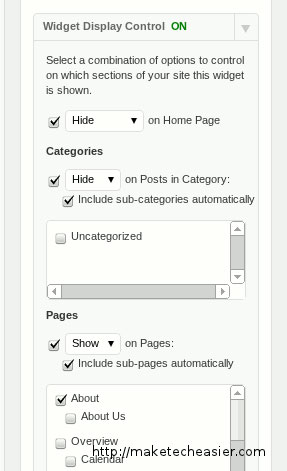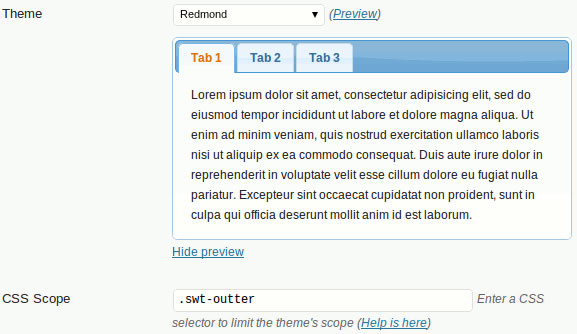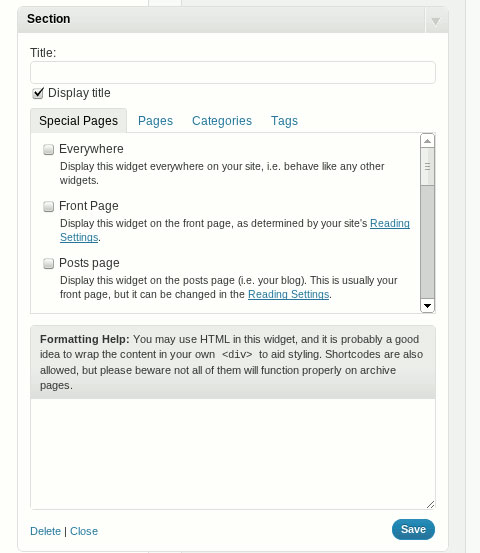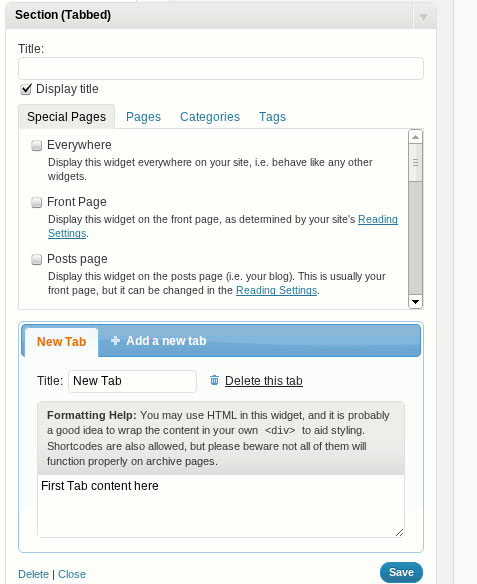Adding dynamic widgets to WordPress blogs without using code
If you own a WordPress site, do you want to display different widgets on every page in your blog? For example, you have a blog about travel in different countries and want a sidebar that displays a French hotel when the article's content is about France, or a widget for Italian restaurants while exchanging. information about Italy . How to do this in WordPress? Especially when not using code. The following article will introduce you to the utilities that can solve this problem.
Conditional Widgets
As its name implies, Conditional Widgets is a plugin that allows you to define a conditional rule for each and every widget.
After downloading and activating the program, go to your Widgets page and add the desired widgets in the usual way. The difference now is that in each widget, there is a option for you to configure it when installing in the blog. See the picture below:

You can make it show / hide on the homepage, certain categories, even for certain pages. It also supports sub-categories and subsites. You only need to define the rules for the parent / catalog, automatically the sub-categories / pages will perform in a suitable way.
However, the program does not allow you to configure on each lesson.
Widget Logic
Widget Logic is less intuitive than Conditional Widget, but it gives users the flexibility to determine the appearance of widgets. Widget Logic uses conditional tags in WordPress to do that.
For example, if you want the widget to appear on an article with an ID of 46, set the conditional keyword is_single (46) in the Widget Logic field.

Section Widgets
The Section Widgets operation method is a bit different from the above two utilities, but this is also the most powerful tool in the 3 utilities that this article wants to mention. Different from logic, Section Widgets also allows you to create a sidebar without writing your own code.
After installation is complete, go to Themes > Section Widget . This is where you can customize the tabbed interface. The program comes with 25 master interfaces to choose from. If you are not satisfied with the topic, you can create your own style.

In the Widget section, instead of having to add a logic condition for each and all widgets, you will add the ' Sections ' widget corresponding to the sidebar so that it appears. Each widget section comes with two parts: The upper section is where you define the conditions (for the page / category to appear). The lower part is to display HTML code.

To add a tab widget, drag and drop the ' Section (tabbed) ' widget to the corresponding sidebar. Similarly, the upper part is where you define the logic, below is where to create tabs and add content to it.

You should read it
- This little trick can make your Widget invisible on iOS 14
- How to disable Widgets on iOS 10 lock screen?
- How to use Color Widgets to create calendar and battery widgets on iOS
- Steps to use BeWidgets to display eye-catching widgets on Windows 11 interface
- Microsoft tests a new, more intuitively tweaked Windows Widget menu interface
- Microsoft confirms Windows 11 users will soon be able to delete news items in the widget menu
- How to stack widgets on iPhone to compact the screen
- Instructions to download beautiful widgets for Xiaomi
May be interested
- More than 10 million blogs stopped working because of a problem
 an incident involving the data center has made over 10 million blogs inaccessible, including top tech blogs like techcrunch and gigaom.
an incident involving the data center has made over 10 million blogs inaccessible, including top tech blogs like techcrunch and gigaom. - Add WordPress.com features to your blog
 with the following tips, tipsmake.com will guide you how to install and use the handy functions of the wordpress.com website on the blog.
with the following tips, tipsmake.com will guide you how to install and use the handy functions of the wordpress.com website on the blog. - Enhance Wordpress security with Plug-in
 wordpress is the most popular blogging platform in the world today and is also used by vietnamese bloggers to customize their personal blogs instead of using available blog services. some of the following plug-ins will help strengthen wordpress security.
wordpress is the most popular blogging platform in the world today and is also used by vietnamese bloggers to customize their personal blogs instead of using available blog services. some of the following plug-ins will help strengthen wordpress security. - Which platform is better for WordPress.com and WordPress.org?
 a commonly asked question is between wordpress.com and wordpress.org, which is the better platform. to help answer that question, today's article will conduct a comprehensive comparison of these two platforms
a commonly asked question is between wordpress.com and wordpress.org, which is the better platform. to help answer that question, today's article will conduct a comprehensive comparison of these two platforms - 9 best iPhone widgets
 iphone is used by many people as a main tool for work and play. and a useful feature that you may not have heard before, widgets, provide a great way to see important information from the apps and services you use the most.
iphone is used by many people as a main tool for work and play. and a useful feature that you may not have heard before, widgets, provide a great way to see important information from the apps and services you use the most. - Why is WordPress free?
 today's article will discuss why wordpress is free, the cost of running a wordpress website and what users get from a wordpress site?
today's article will discuss why wordpress is free, the cost of running a wordpress website and what users get from a wordpress site? - 10 free WordPress plug-ins for bloggers
 if you are a blogger using wordpress, the following article will provide you with powerful free support plug-ins, helping you build a complete blog.
if you are a blogger using wordpress, the following article will provide you with powerful free support plug-ins, helping you build a complete blog. - Dynamic website design with Drupal source code 7 - Part 1
 drupal is a free, very powerful, stable and powerful content management (cms) system, built over 10 years ago. the stability and robustness of drupal's core has made this code available to use from small blogs and websites to large collaborative social networks ...
drupal is a free, very powerful, stable and powerful content management (cms) system, built over 10 years ago. the stability and robustness of drupal's core has made this code available to use from small blogs and websites to large collaborative social networks ... - 5 mistakes everyone mistakenly thinks about WordPress
 wordpress has developed much beyond the original feature as a platform for bloggers.
wordpress has developed much beyond the original feature as a platform for bloggers. - What's new in WordPress 5.4?
 on march 31, the latest version of wordpress 5.4 was released and named after nat adderley, a trumpet player, continuing the tradition of naming wordpress releases after jazz artists.
on march 31, the latest version of wordpress 5.4 was released and named after nat adderley, a trumpet player, continuing the tradition of naming wordpress releases after jazz artists.










 'Backdoor' plugin, WordPress 3.2 RC2 launches
'Backdoor' plugin, WordPress 3.2 RC2 launches Hackers break into WordPress servers
Hackers break into WordPress servers WordPress.com blog service collapsed because of a DoS attack
WordPress.com blog service collapsed because of a DoS attack Build a blog with WordPress
Build a blog with WordPress Open your own online store with WordPress
Open your own online store with WordPress